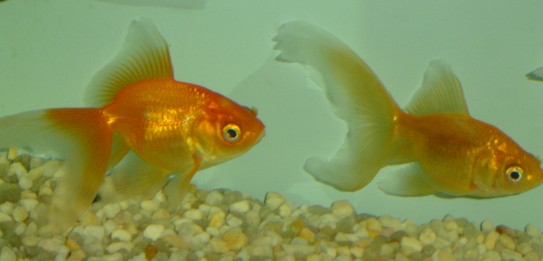Fantail Gold Fish
Cyprinidae
Excellent Pond Or Aquarium Goldfish
Fantail gold fish are another hardy fish that are good for the beginning aquarist.
They only grow to a moderate size (approximately 6 inches) and are quite manageable either in a pond or an aquarium setting.
As with other goldfish the fantail is a pretty messy fish to put it mildly.
You will need to regularly clean the tank even if it is properly filtered. In terms of food the fantail gold fish will eat all sorts including flake and pellet food, blood worms and frozen food.
It is best to feed them once per day and only enough food so that there will be no food left on the surface or on the bottom after five minutes.
Fantails have an egg-shaped body and can have a variety of colors including red, white, black, calico or a mixture of several of these colors.
Their distinctive tail is obviously their defining quality from which they’ve been named.
Their tails really can be quite beautiful.
To be accurate it is their caudal tail (tail fin) that is like a fan that billows out as they casually swim up and down the tank or pond.
I really find the forking of the tail fin a most beautiful feature of the fantail.

You should keep the fantail with other fantails (not females together!) or even other goldfish as they like to school and swim together.
On the other hand, they have been kept successfully individually.
But beware, they are a rather slow swimming fish and other quicker fish might get to the food first.
And remember, never overcrowd your tank because this almost always leads to stressed and diseased fish.
Just think of that word for a moment: dis-ease.
It obviously means not “at ease” and it is this condition that can really affect your fish spectacularly in a very short amount of time.
Conversely, if you have the right conditions your fantails will display signs of optimum health including a healthy appetite, clear bright eyes, shiny scales and active swimming.
Fantail Gold Fish Sidebar - Did You Know?
These goldfish were the first to be bred in captivity on a very large scale.
If your fantails do become sick make sure you follow good tank protocols by removing and quarantining the sick fish and putting it in a "sick tank" to nurse it back to health if possible.
Make sure you also treat the water of the main tank so that any fungal or other infestation may be cleared as quickly as possible so the problem doesn’t spread to the other fish.
This might also include a partial water change and checking the temperature as well as the chemical composition of your tank water.
They like breeding during the season of Spring and are egg layers.
You might need to get some plants like java moss, elodea and anubias so that the parents don’t eat the small fry after birth.
Fantail Gold Fish Ideal Conditions
Tank: Outside pond or large inside aquarium
Water temperature: 60-80 degrees Fahrenheit
Ph: Ranges between 7 and 8
Feeding: Feed once per day. Enough food to be consumed in five minutes. Flake and live foods (see above)
Water Change: Once every two weeks at least, 30% at a time
Filtration: Good Filtration system & plenty of swimming room
Breeding: Egg Layer
For more information on
fantail gold fish and others click here...
And here's a little video of a healthy fantail gold fish on YouTube.com...
Enjoy!